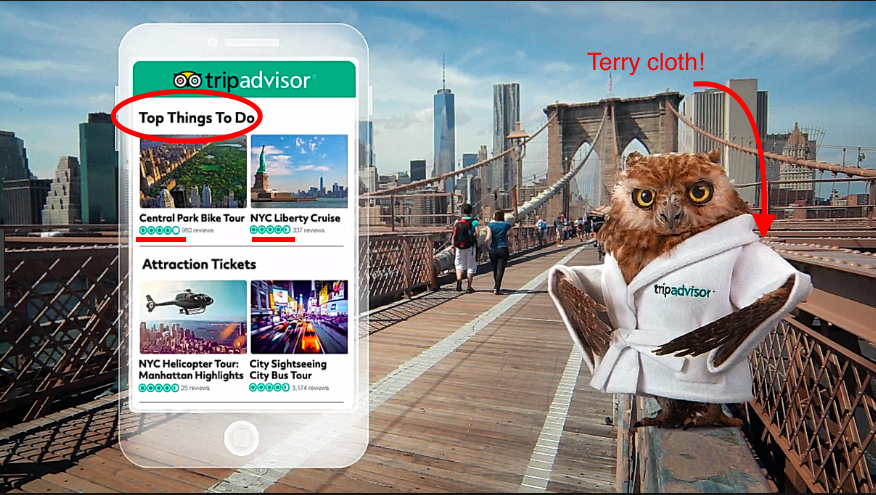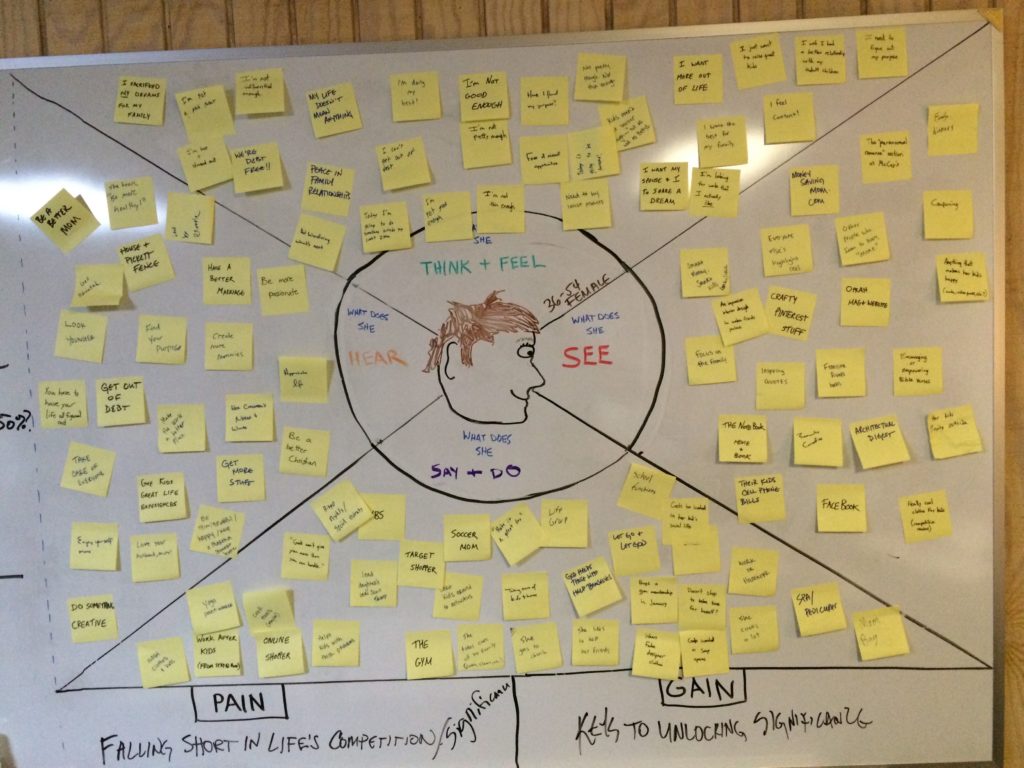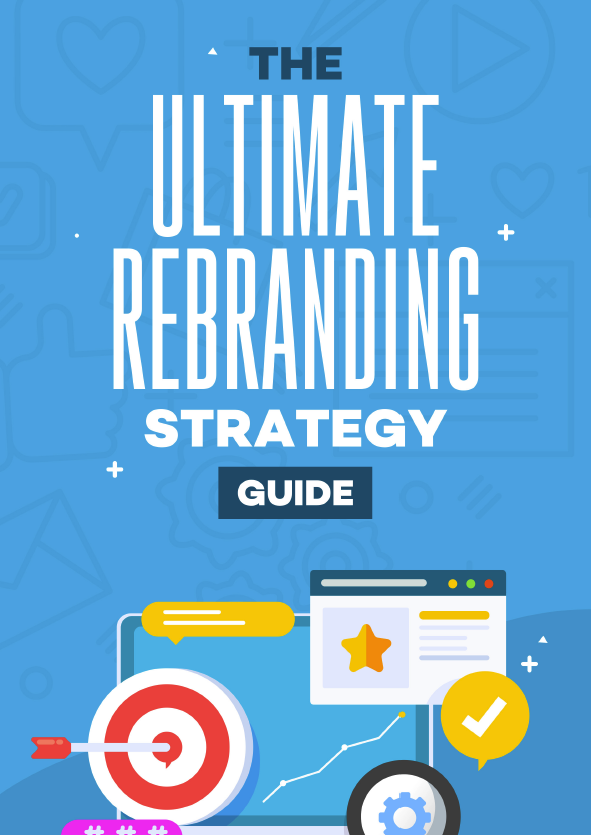I swear it’s the same every time.
I’m in a conference room with a few people, all of them invested in building a new business.
I can see the passion in their eyes, and I can feel the strength of their vision. And I get this weird sense.
It feels like I’m afloat in an ocean of potential.
And then it hits me. It’s the same realization every time.
All we have in front of us is potential. It’s endless. And it’s exciting and terrifying at the same time…
Because it’s up to us to turn that potential into success.
But if you’ve never done it before, that ocean of potential feels more like an ocean of confusion —
A never-ending string of questions you can’t answer.
Think of this post as a rescue boat. My goal is to pull you out of that ocean of confusion and onto something with a bit more hope.
What is a Brand Strategy?
For our purposes today, we’ll define brand strategy as:
The steps your business must take to get from “I have an idea” to “I’m making money.”
In this brand strategy template, we’ll address the three major components of a failsafe brand strategy:
- A clear Purpose Statement
- A narrowly defined Target Audience
- Consistent Brand Messaging
Let’s walk through some real-life brand strategy examples to give you some clarity what a brand strategy actually looks like.
3 Great Brand Strategy Examples
1. Oprah Winfrey
Purpose
“To be a teacher. And to be known for inspiring my students to be more than they thought they could be.”
Target Audience
Oprah is targeting students (life-long learners), but more specifically, she’s targeting her students.
She had the benefit of building a worldwide platform every afternoon on network television, but she’s not even targeting the viewers of that show!
Instead, she’s targeting the individuals who have followed and continued to learn from her since that exposure.
Genius.
Example of Consistent Brand Messaging
You might think that, since Oprah is a worldwide brand, she would be inaccessible.
But a teacher is never inaccessible to her students.
To put her brand purpose into action, Oprah took the time to interact with her students’ Instagram accounts.
These inspirational comments were meant to not only enhance her students’ lives but also to incite them to impact others with their platform.
2. Toyota
Purpose
“To attract and attain customers with high-valued products and services and the most satisfying ownership experience in America.”
Target Audience
Because Toyota’s products are high-value but not necessarily high-priced, they’re implicitly targeting customers interested in that class of product.
Toyotas are competitively priced products, but their customers bank on the reliability of those products.
Those tenets are closely held in everything Toyota releases.
Examples of Consistent Brand Messaging
Toyota is one of my favorite examples of brand messaging consistency.
They’ve integrated their core purpose with their company culture by instituting the Toyota Way. It’s an intercompany mandate to always improve and never settle.
That indoctrination into the company DNA means the only type of customer service you experience with Toyota will be positive, and the only type of product or service you will receive is high-value — which directly aligns with their purpose.
3. TripAdvisor
Purpose
“To help people around the world plan and have the perfect trip.”
Target Audience
Trip-takers. They’re not going after the folks sitting at home twiddling their thumbs.
Example of Consistent Brand Messaging
It’s likely you’ve seen an ad like this one before.
Check out a couple of things.
- Ratings from its members telling you the value of the experience.
- The “Top” moniker, denotes an experience that will enhance your trip.
- Lastly, a terry cloth robe on their mascot. (Who doesn’t feel like terry cloth robes make vacations perfect???? Also, who wears terry cloth at any other time in their lives?)

**You’ll also notice that they placed their site screenshot on a smartphone. This subtly insinuates their advice will be with you on your trip, ensuring the perfect vacation. Smart!
How to Create a Brand Strategy
Now that you’ve seen a few brand strategies in action, you should have a better idea of what your own brand strategy might look like.
As I noted earlier, there are three major components to a brand strategy:
- A clear Purpose Statement
- A narrowly defined Target Audience
- Consistent Brand Messaging
But now, let’s break down the process step-by-step, so you have everything you need to start creating your brand strategy.
1. Identify Your Brand’s Purpose
We’ve hit on this with other blogs more in depth, so we’ll spend a little less time on it here.
Your goal in this step is to find the answer to a single question:
Why is my brand in business?
Full disclosure:
Your answer can be altruistic or selfish (we recommend altruism), but the main thing is that it must be sincere.
As an example of a “me-focused” purpose statement, look at Richard Branson:
“To have fun in [my] journey through life and learn from [my] mistakes.”
If you go the altruistic route, the format you’re looking for is:
“I help X person accomplish Y goal.”
At Leverage Creative Group, ours is:
“We exist to give renowned thought leaders and innovative companies the ability to reach as many people as they can with their message online.”
Then, you want to boil that down into a mantra that you can easily use in internal and external communications. Bonus points if you can narrow it down to one word.
Our is simply:
Amplify.
So, how do you determine your brand’s purpose statement?
First, identify your core values.
Your core values determine how you will live out your purpose statement and the types of people who will be in your audience.
Let’s look at Oprah again.
We can’t know her core values without getting some inside info, but we can guess from her mission statement that she values…
- Continuous learning…
- Encouragement…
- Inspiration…
…with the ultimate goal that, by living out those values, she will lead her students to action.
How did we come up with those values?
We looked at her purpose statement:
“To be a teacher. And to be known for inspiring my students to be more than they thought they could be.”
Notice the teacher/student language she uses and the inspiration language tied to helping her students take action.
As you can see, your values tie directly into your purpose statement.
And the second major factor in your Purpose Statement is your audience.
Defining your core values will make your mission statement more genuine, which should make it resonate more with that audience.
An insincere attempt to resonate with an audience that doesn’t align with your core purpose isn’t going to flatter anyone.
(Remember when Radio Shack rebranded to capture a younger audience?)
In Step 2, I’ll show you how to gain a better understanding of your target audience.
2. Identify Your Target Audience
I almost used Coca Cola as a brand strategy example earlier in this post. But I left them out for a very specific reason—
They have the broadest target audience I’ve ever seen in a mission statement (emphasis is mine):
“To refresh the world…To inspire moments of optimism and happiness…To create value and make a difference.”
Check that out.
“To refresh the WORLD!”
That broad of a target audience works for a global brand. But it’s a bad example for right now.
Why?
Great brand strategies for young businesses focus on a narrowly defined audience.
Conquer that niche first. Then, in 100 years, you too can use the entire world as your audience!
For now—
Think about who your core offering would help the most.
Be specific.
Your goal is to create an “avatar” — a detailed representation of your one best customer.
If you’re in the real estate business, your avatar might be Jim, a 32-year-old computer programmer with a wife and two young sons.
Ideally, you would know as much information as possible about Jim—
Things like his biggest challenge with buying a house, his hobbies, the shows he likes to watch, his favorite books, even some of his favorite foods.
If that sounds creepy, remember two things:
- Jim is not a real person. He’s just a representation of your target market. He’s not going to get creeped out, I promise.
- The purpose of creating an avatar is to serve your customers better. If you know what they’re like, you’re better equipped to give them what they need.
The better you understand your avatar, the more likely you are to connect with them in your brand messaging too.
We recommend creating an Empathy Map to get a feel for what your target audience experiences on each day.
This is your chance to get inside the head of your target customer, and see what life is really like for them.

An Empathy Map from one of our target customer brainstorming sessions.
Creating an Empathy Map lets you think through what your target customer hears, thinks, sees, and does on a daily basis.
The goal is to identify their biggest pain, as well as the biggest gain you can give them through your product or service.
If you don’t have a specific avatar like Jim yet, that’s okay for now. You’ll eventually want to create one to help with your marketing efforts…
But for the purpose of your brand strategy template, it’s okay to simply identify the group of people you serve best.
For example, at Leverage, our target audience is:
Innovative companies and renowned thought leaders.
3. Communicate Your Brand’s Purpose To Your Target Audience
We can talk about branding fails ad infinitem.
- Pepsi’s failed Kendall Jenner commercial…
- Zaxby’s “Open on Sundays” commercial…
- Lifelock CEO’s dare to steal his identity…
…and that’s just from the past few years.
So, how do you avoid ending up on a list like this?
Always tie your brand’s messaging to its core purpose.
Every branding decision you make — from website copy to brand colors to logo — should reflect your brand’s core promise to its target customers.
The most successful brands do this over and over again.
Toyota: The Brand Messaging Consistency Test
Let’s take a peek under-the-hood of Toyota’s brand messaging (Not even sorry for that pun.):
Does their brand messaging consistently communicate their purpose to their target audience?
Their stated purpose:
“To attract and attain customers with high-valued products and services and the most satisfying ownership experience in America.”
Round 1: Internal Messaging
We mentioned The Toyota Way as a guiding principle for company operations earlier. Let’s see where that fits in.
Here’s a blurb on the Toyota Way from their European Website (emphasis mine):
“The Toyota Way is built on two pillars: Continuous Improvement, which takes in the concepts of Challenge, Kaizen and Genchi Genbutsu, and Respect for People, which embraces Respect and Teamwork.”
Does that align with their stated purpose?
“Continuous Improvement” certainly seems like a way to guarantee that services and products remain high value…
That one passes the test.
But what about “Respect for People?”
Will that guarantee “the most satisfying ownership experience?”
Imagine your Corolla is out-of-alignment, so you take it to a Toyota dealership.
The whole time you’re there, you’re treated with respect and your car gets the repair it needs. You might even get some free coffee or a snack while you wait.
Sounds satisfying to me!
All right, so this internal culture built around continuous improvement and respect for people does line up directly with their purpose statement.
Fine, Toyota. You win that one…
Round 2: External Messaging
Let’s keep this simple.
I’m just going to Google search “Toyota ads” so click this link and follow along.
Notice that each ad speaks to why you should love owning one of these cars.
Whether it’s the truck taking you off-road, the hybrid protecting the environment, or the concept car keeping you at the cutting edge of innovation, the message is clear—
Owning a Toyota is satisfying.
You should also notice that these Toyotas look extremely high-value.
Of course, that’s nothing new to car ads, but they back up these pictures with social proof of awards that prove the high-value.
They hit the nail on the head. Again.
Results
Toyota gets it.
Here’s how you can be like them:
- Let your purpose flow through your company’s culture and the communication between your staff.
- Let that internal communication and commitment to the brand’s purpose flow outwardly in your marketing material.
- Don’t forsake any step along the way. It’s hard work. It’s necessary work.
Conclusion
This is where I’m supposed to wrap up this post with some incredible example of encouragement.
The truth is…
You don’t need that.
You need a practical guide to get you from where you are to where you want to be.
So, our team has put together the attached brand strategy template. Download it now. Take the time now to invest in your company’s future.
Why?
Look at this list. These are the top 10 companies in the world (by revenue) with their founding date in parenthesis:
1. Walmart (1962)
2. State Grid (2002)
3. Sinopec Group (2005)
4. China National Petroleum (1998)
5. Royal Dutch Shell (1907)
6. Toyota Motor (1937)
7. Volkswagen (1937)
8. BP (1909)
9. Exxon Mobil (1882)
10. Berkshire Hathaway (1839)
Notice anything?
Six of those companies didn’t exist 100 years ago.
Think about that.
The business landscape is always changing. And you can be a part of that change…
But you need a plan.
Take the first step to writing that future today.
In the comments below, tell me the first step you’re going to take.

